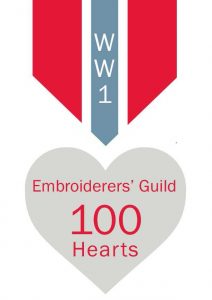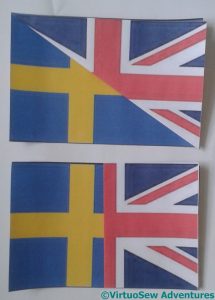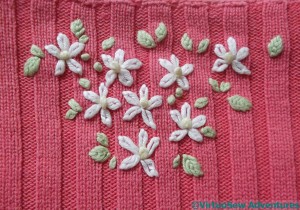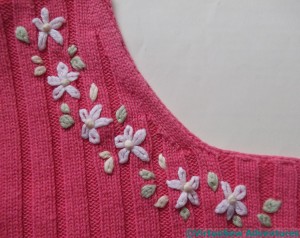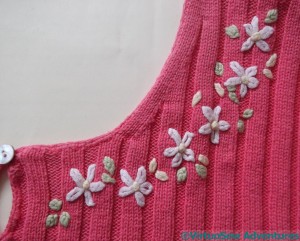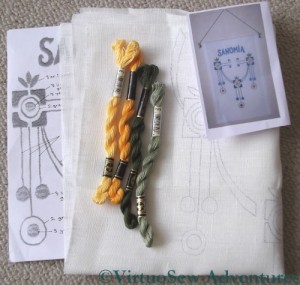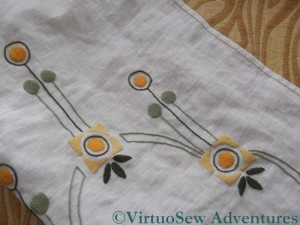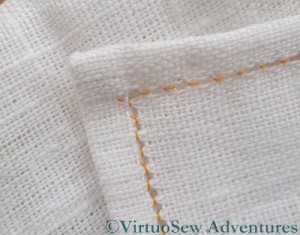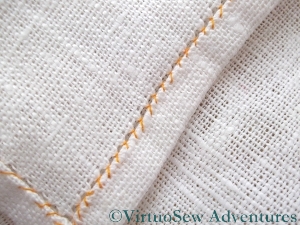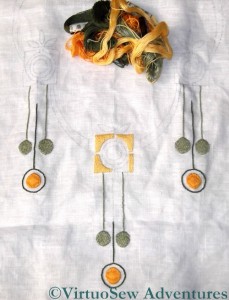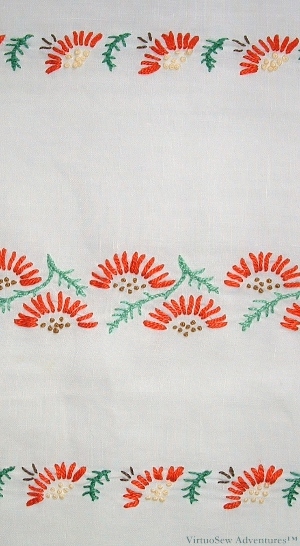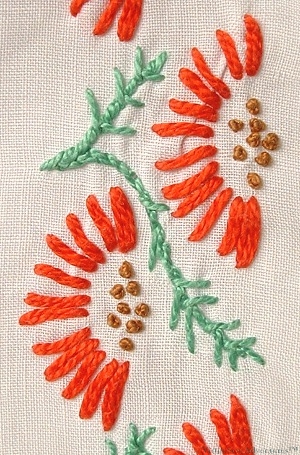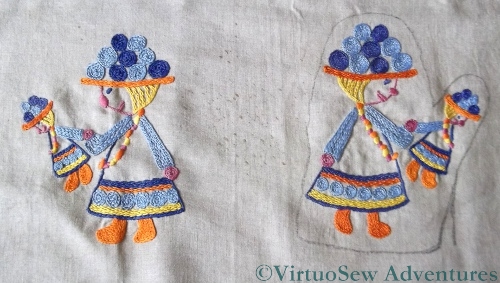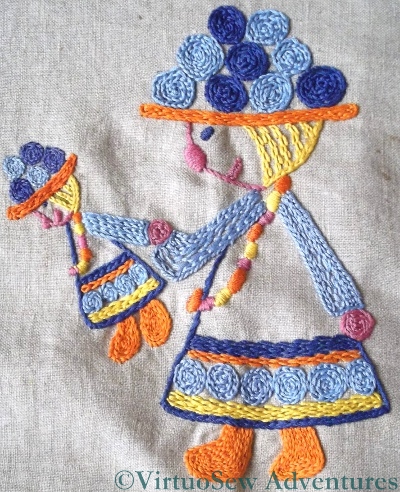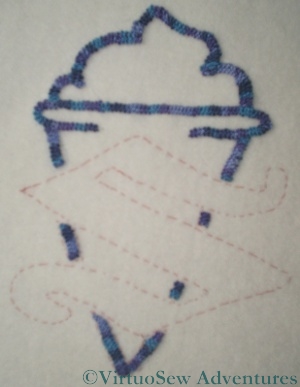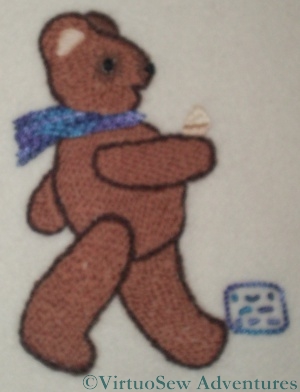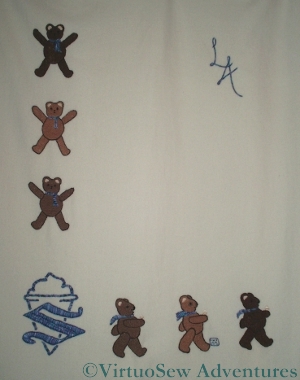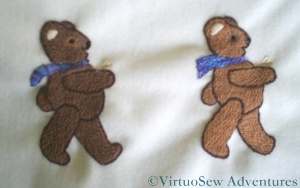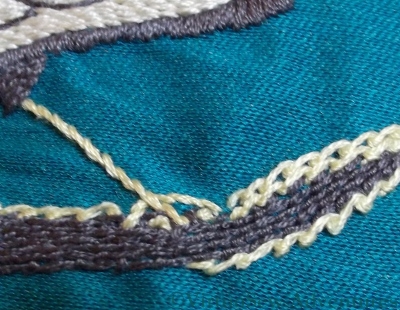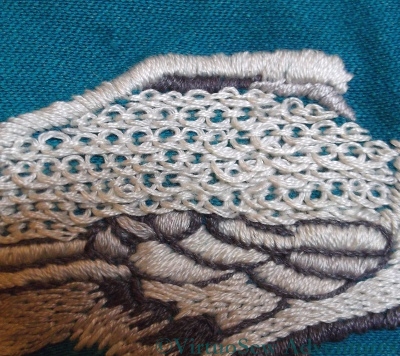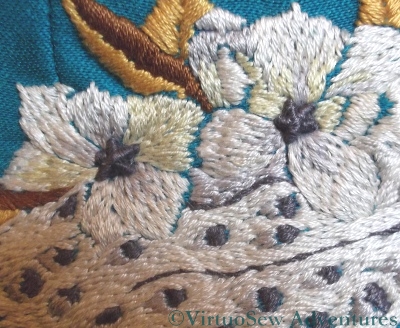Tag: design elements
The Embroiderers Guild “100 Hearts” project
I am now a member of The Embroiderers Guild, and when my membership card arrived, so did some information about a project they are doing in collaboration with SSAFA, called “100 Hearts”. It offers embroiderers and textile artists the opportunity to create their own memorial to all those who fought and died or came back changed, to all those who kept the home fires burning, and, in summary, to all the many untold stories of that time.
Now, generally speaking I’m not very good at responding to a brief I’ve not created myself, but as I sat reading the information and pondering whether to join in, I thought about my Grandmama, who taught me to embroider, but who would probably be bemused and (I hope) impressed in equal measure by what I have done with what she taught me. Her father was a Swedish immigrant to the UK, who became a British citizen shortly after her birth. He won’t have been a young man when the war broke out, and I’m sure he wasn’t called up, but he was a mariner, and I expect that he was working in coasting freighters, keeping the supply of food and fuel moving. From that I thought that he could stand for the many immigrants and naturalised citizens who, in the face of the hysteria and suspicion of the time, continued to serve their adopted home loyally and well.
So my design will be specific and local – he lived in South Shields, and I’m using the headland and the shape of Tynemouth Priory to stand for that – but it stands for much, much more than that.
I will be searching to see what more I can find out, about Great Grandfather, about what he might have been doing, and about what records there may be concerning the war service of immigrants and naturalised citizens, and we will see what I manage to come up with!
To begin with, I want Tynemouth Priory to be set against a “sunset” of the two flags of Sweden and the United Kingdom. I had originally misremembered that the gold cross on the Swedish flag was essentially the same as the cross of St George, but no, the vertical line is set closer to the hoist (the part of the flag nearest the flagpole).
Once I’ve decided how large my sunset needs to be, I can start stitching it while I go to have a look at Tynemouth priory….
Embellishing a summer top
Since summer is here (supposedly!) I’ve changed to summer clothes. Pink is not usually my colour, but I found this top in a charity shop and it goes beautifully with the crepe skirt I was wearing that day.
However, I got slightly twitchy fingers and improvised some embellishment for it. The top is knitted in quite a heavy cotton, so the embroidery is in soft embroidery cotton, and it’s very, very simple.
Only three colours – white, pale yellow and pale green. And only three stitches – Lazy daisy petals, French knot buds and flower centres, and leaves made of nested fly stitches. I didn’t attempt to make the sides at the front identical or symmetrical, only to make the front appear balanced, and when I’m wearing it, it does. The ribbed knit of the top made stitching tricky at times, since I was trying to avoid piercing the thread, but perfection is overrated, especially for a casual top.
The little spray of flowers at the back does get seen (by others!), because although I have long hair, I almost always wear it pinned up; but of course the frustrating thing about embroidering the back of a dress or top is that you never get to catch sight of it unexpectedly and get the chance to think “I did that!”.
Never mind, like the contrast lining or facing, I still know it’s there…
Finnish Embroidery
A few weeks ago, my husband the Australian was speaking at a conference in Turku, Finland, and the organisers were kind enough to allow me to go too. We had a marvellous time – the Finns are terrifyingly good linguists, so we had no language problems, and because the conference was about Science and Art, and how they feed off one another and contribute to one another, the conversations were very wide-ranging, full of sparkle and fun.
I didn’t have much time for side trips, but I did find an embroidery shop, and asked about local rural Finnish embroidery. I picked a design I liked the look of, and they agreed to prepare a tracing for me and send it on. It seems to be in a combination of stem stitch and Bokhara couching, but when I’ve had a closer look at the stitch diagrams, I will be able to tell you more.
This is what the lady in the shop told me about the design:
You also asked for some information about the pattern, we have a book that tells a brief history of where the pattern was found. Of course, the original designer of the pattern is impossible to trace.
The pattern was originally embroidered on a bag or pouch, that was hanged on the wall, where people put smaller newspapers and magazines into. That’s why the pattern is called ”Sanomia”, it means messages or news in finnish. The word was also embroidered in the bag. We copied the model ourselves to other products, such as runners.
The ”Sanomia”-newspaper bag was found in the Kankaristo house, in country village of Mynämäki.
The bag, that was found there, was sewn by the lady of the house, Helli Kankaristo, born in 1902. The story tells that she was taught to make embroideries by her very skillful teacher at school, and Helli passed her skills also to daughter Inkeri, born in 1928.
The Finnish Table Runner is Finished!
At long last… I have finished the Finnish Table Runner!
The embroidery itself is very simple – Bokhara Couching and Stem Stitch, with the darkest leaves worked in nested Fly Stitches. I used two shades each of two colours – a greyish green, and a golden yellow.
The couching stitches of the Bokhara Couching are carefully arranged to create a basketweave effect, and I worked harder than usual to make the stem stitch regular with an even twist to it. Real simplicity is hard work, because the simpler the tools and effects you are using, the better-executed they have to be!
So I have taken particular care to stitch evenly. This was not entirely straightforward, in fact, as the fabric is a plain weave (one thread over and one thread under in each direction) but is not a square weave (warp and weft threads equally spaced). Since it is also a linen, and the threads are a little slubby, sometimes the effect is exaggerated. This became especially clear when I worked the hems.
Incidentally, I’ve no objections at all to the fabric not being a square weave or to the threads being slubby – these are just factors that sometimes influence how something is worked or the effects that are achievable.
When I hemmed the piece, I chose to use Antique Hemstitch (at least, that is what it is called in Yvette Stanton’s Right Handed Embroiderer’s Companion). This leaves only a small stitch on the front of the piece. I withdrew a single thread for each hem (the instructions usually suggest at least two, but I wanted a narrow line down the edge and not the dogtooth effect of hemstith on only one side of the withdrawn threads), and then grouped four threads in each stitch. If you look hard at the photos, you will see that in one direction the stitches look longer than the other, although they group four threads in each case.
Since the table runner is about a metre and a half long, and nearly half a metre wide, that’s about four metres of hemming, which for some strange reason I enjoyed enormously, even though I’m really not good with repetition. I used ordinary sewing thread, but decided to use a golden yellow to add a bit of colour along the edges.
When my mother saw it first (half-done), she told be I was being a little show-off, but I think she meant it as a compliment!
Progress on the Finnish Embroidery
I managed to get started on my Finnish embroidery project at last. It’s going to be a table runner for our dining room, which is golden-yellow and decorated in a slightly Arts and Crafts fashion, so the design has been traced twice, back to back, to create a long design, and without the lettering shown in the photograph that accompanied the linen (see my first post about this project).
Following the model I saw in the shop, I’m using Bokhara Couching for all the solid shapes, laying the couching stitches in a sort of brickwork pattern to create texture. The deep golden circles will echo the sunburst in the eucalyptus frieze in the dining room, and the two greyish greens are close to the other colours in the frieze.
All the lines are going to be in stem stitch. I’m working this quite slowly and carefully to keep the stem stitch twisting neatly in the same direction and the stitch length more or less the same.
It’s some time off yet, but I’m planning to hand-hemstitch the edge of the runner. I take a slightly unexpected pleasure from hand-hemstitching, and even the six metres of hemstitching on the Piano Shawl haven’t put me off. There’ll be about three metres of hemstitching on this, and I’m rather looking forward to it!
Another early piece
I worked on this very early in my embroidering career. The design comes from a free transfer in one of the Needlewoman Magazines my Grandmama gave me (September 1934, since you asked!), and I worked it to go with the curtains in my bedroom which were a wonderful Regency strip in red and gold. It’s a table runner – I used it on my dressing table – and it is very nearly two feet long.
The original article to accompany the transfer described several different colourways and a whole range of sketches of suggested uses. There was the idea of sprigging (organdie) curtains with the single motif, embroidering a sunshade, a bag (linen), a luncheon set, gloves, embellishment on the brim of a hat, even on a nightdress or slip (silk of course!). Sometimes I wish I had lived in the Thirties!
I used some fine linen – essentially altar linen, a fine even-weave, nothing fancy, and embroidered it using pearl cotton. As you can see from the close up, pearl cotton really was rather too heavy for the fabric, but then I liked it at the time, and if you don’t like what you’re doing, it tends to take longer to finish.
I should have had the courage of my convictions and worked the French Knots as seed stitches (I hated French Knots at the time – possibly because I wasn’t very good at them). There are only three stitches – straight stitch, stem stitch, and French Knots, so it was very easy and simple to work.
I simply had to keep going at it. That’s when I discovered that I’m not very happy doing repetitive embroidery!
And – in case you are interested – although the linen was old when I worked the embroidery, it has in fact outlasted the bedroom curtains… They don’t make fabric like that anymore!
Finding Forgotten Projects
Every now and again, I find early – and usually not-quite-finished – embroidery projects stashed away in a quiet corner. This is a case in point.
This is very early indeed, probably from my first year of embroidering. The design came from a very nineteen-seventies book of embroidery designs that will have to remain nameless unless I can find it again. I suspect that I went for this design because it was in colour rather than variations of Mud!
Other than that, I can’t find any excuse for it at all. The design was intended to embellish oven mitts, and when I get a chance I will probably finish them to make a pair and then put them in a church bazaar. Alternatively, I might outline the glove shape on both and then turn the fabric into a bag, which would be rather more use than home-made oven mitts now we all use those fire-retardant gloves.
I have noticed, however, that my passion for experimentation showed itself even at this early stage. I’m absolutely certain that the sleeves didn’t have that Closed Feather Stitch stripe down them in the original piece.
I also distinctly remember that I nearly ran out of thread and had to do some some very economical stitching to get everything stitched in the threads I’d picked out.
Frolicking Teddies – Part Two
The logo on the Frolicking Teddies Cot Blanket was an interesting element to work. It consists of a letter “S” superimposed over an ice cream cone. Clearly as a graphical element, it needed to be consistent in feel – achieved by using the same thread in each part of the logo – but I also felt that stitches that would work for the “S” might not work for the ice cream cone.
In the end, I used the ordinary Braid Stitch for the ice cream cone, producing a strong, textured line. This is actually an easier stitch than it looks, and in fact when I have a broad line to cover, braid stitch is one of my favourites.
The “S” was a slightly harder question. I wanted it to be solid and “blocky”, and yet not to have excessively long stitches that might catch. I also wanted the thread to show to its best advantage. In the end I stitched most of it in vertical satin stitch, but outlined it in stem stitch and then created an ornamental line down the widest part, taking my cue from the pierced effect sometimes used for capital letters in illuminated manuscripts. I think this may well be the element I am most pleased with!
As this was a commission, of course I signed my work. One of the Marching Teddies is kicking a small cartouche in which my initials are worked – in Morse Code, as has become my habit, using French Knots and Bullion Knots.
I decided to line the Cot Blanket. With silk, of course. Although I rather doubted that it would be used except on special occasions, I thought it would be better to protect the back of the work from little kicking feet and little sharp nails! Attaching the lining was a time consuming operation, since I had to make sure it was very firmly attached, without pulling or dragging at any point.
I also provided a tiny leaflet explaining the idea of the design and saying a little about how it was done. This was my very first real commission, and I am glad to report that the client was delighted.
Frolicking Teddies – Part One
The “Frolicking Teddies” were created in response to a commission to produce an heirloom Cot Blanket for a much-anticipated first grandchild. In the initial stages of planning, the child’s sex had not been determined, so we planned a gender-neutral design of Teddies. I was also asked to include the logo of the family ice cream business, so in the end settled on a story of exuberant, star-jumping teddies down one side, with the logo in the lower left corner, and a procession of teddies with ice-cream cones in their hands (sorry, paws!) walking from left to right.
Once the child’s gender and name became known, I chose the colour for the logo and embellishments, and then added his initials in the top right hand corner. The initials gave me some concern, in fact. I usually use Portuguese Knotted Stem Stitch when I want a heavy line, but when I’d completed the Teddies and the logo, I felt that that would create too heavy an effect in the top right hand corner. I settled on Heavy Chain stitch, which produces a smooth, strong line, but doesn’t have quite the overbearing personality of the Portuguese Knotted Stem Stitch.
Since the commission was explicitly for an heirloom, I used cashmere blanketing as the base fabric. Fortunately, since it’s not easy to get in the UK, we were visiting my husband’s family in Australia at the time I was sourcing the materials. It’s really a lovely fabric to work with, and I still have some left, awaiting further inspiration. Or another commission!
The teddies are worked in long and short stitch using Paterna Persian wool. The only challenge there was the tension of the stitches, since it was especially important not to pucker the fabric. At the same time, I didn’t want the stitches to be too loose and snag on anything…
The ice cream cones were worked in stranded cotton, and the logo, initials, and the Teddies’ scarves were all worked in a standard variegated pearl cotton. Each scarf is worked in several rows of a different line stitch – stem, chain, Portuguese knotted chain, and so on. This was a way for my passion for stitches to inform and adjust the design, while remaining closely within the brief.
More Details on the Peacock Skirt
Do you remember my Peacock Skirt? Megan of Elmsley Rose asked for some more close ups of the embroidery, and while I have been remodelling it (for a slightly less sylph-like waistline – I was a skinny teenager!) I took the opportunity to take some.
This, therefore, is a close up of the branch the peacock is standing on. I simply followed the instructions here, using coral stitch for the dark grey elements of the branch and scroll stitch for the pale yellow. I think that now if I were do something like this again, I would spend a bit of time tweaking the colours a little more, because I’m not sure I like having the peacock’s legs the same colour as the highlight on the branch!
You can see, too, that I struggled somewhat with tension and the fabric is a little puckered. This seems not to matter when I’m wearing the skirt – people still admire it!
The instructions for the Peacock’s back said to work the Pekinese Stitch fairly loosely to create a slight variation on colour and texture. Since the embroidery was worked in two strands of stranded cotton, that too contributes to a slightly “fluffy” appearance. The satin stitch sections around where the wing should be are in slightly different shades of grey, and worked at slightly different angles, again to produce varying tones and textures.
Looking at this close up now, I think the rows of stem stitch used for some sections of the body represent the feathers of the bird more successfully (although, again, the design doesn’t attempt a photo-realistic representation) than the sections of satin stitch or pekinese stitch. I do admit, however, that it was the chance to work pekinese stitch that attracted me to the design!
The centres of the flowers were worked using a Spiders Web Wheel. The instructions specified working as much thread into the stitch as possible to obtain a raised and highly textured effect. This contrasts very well with the long and short stitch flowers and the stem stitches on the peacock’s tail.
Again, coming back to these pieces years after stitching them, it’s fascinating to look at surprising details. The gold and russet leaves look as though they’ve been padded, but I’m quite sure they weren’t. I remember doing padded satin stitch for the first time quite recently and wishing I’d known about it earlier!

